LAW5211 Semester 3: Doctrine of Separation of Powers in Australia
VerifiedAdded on 2023/04/24
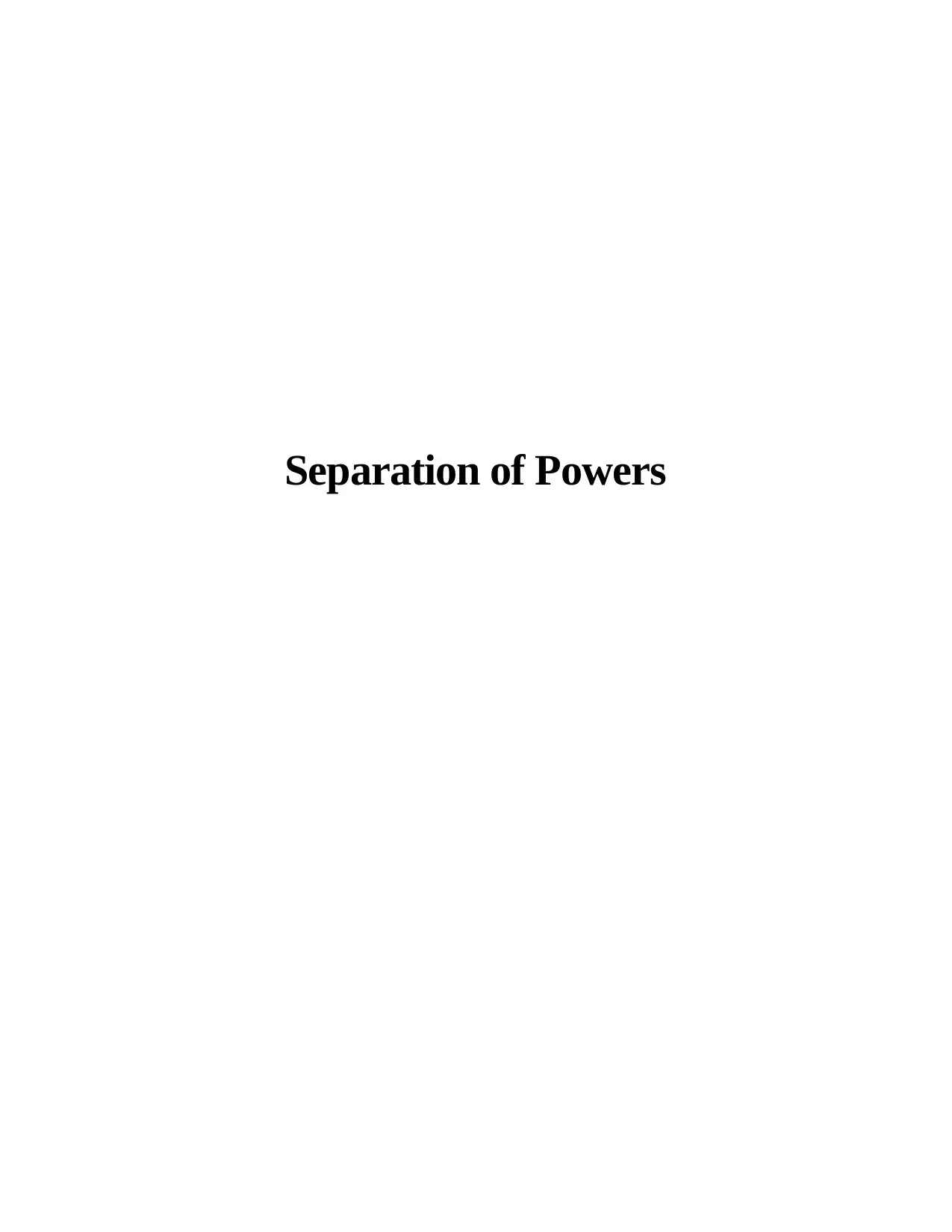
Paraphrase This Document
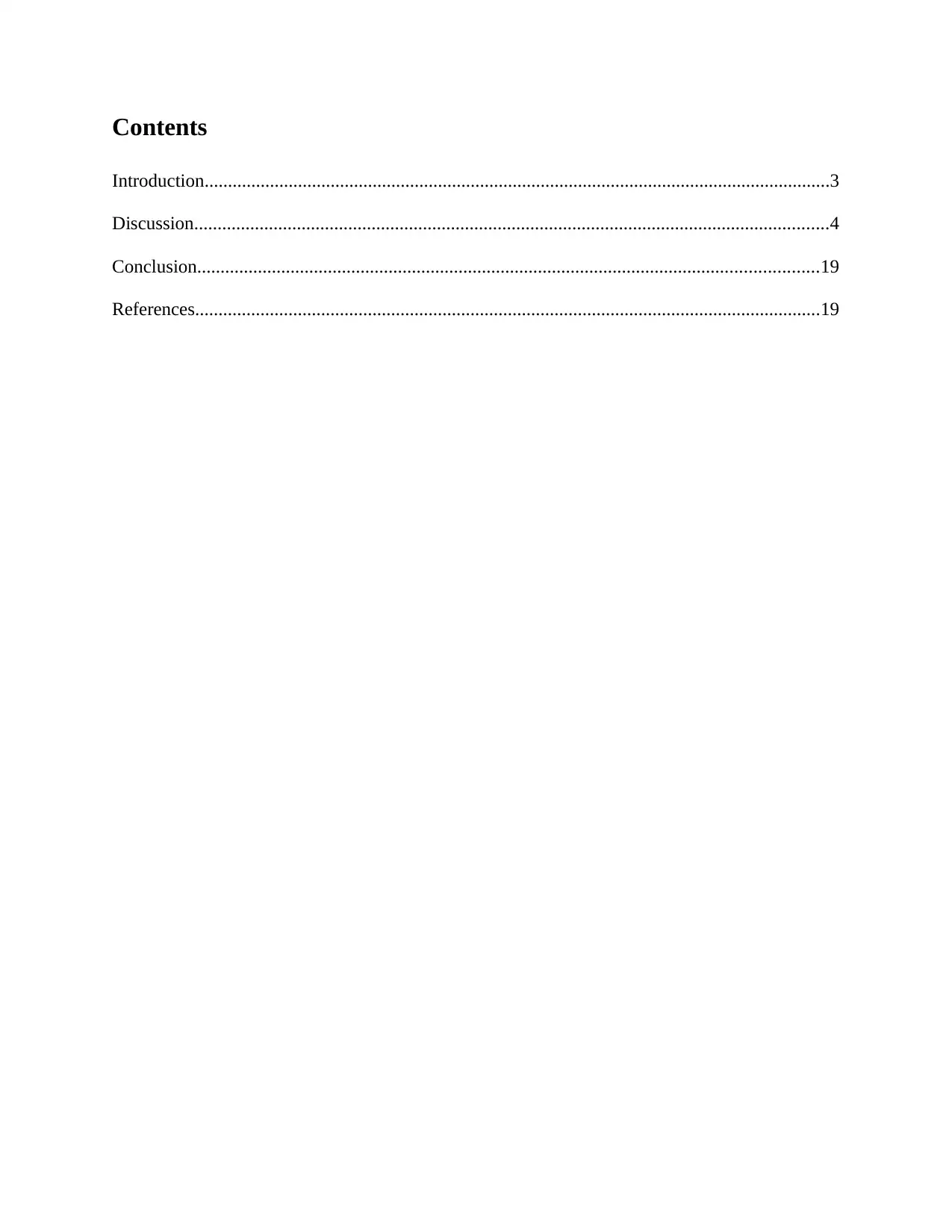
Introduction......................................................................................................................................3
Discussion........................................................................................................................................4
Conclusion.....................................................................................................................................19
References......................................................................................................................................19

Separation of powers is a constitutional law doctrine under which, there is separation maintained
in all the three branches of government i.e. Legislative, Executive and Judicial branches. This
doctrine is also known as the method of maintaining equilibrium because every particular branch
is provided with certain powers in order to maintain equilibrium among all other branches of
government. Each group of government has separate powers and is not permitted to implement
the powers of other groups. The Executive Branch is related to the implementation of executive
power, the Legislative Branch workout congressional power, and the Judicial Branch workout
judicial review. The Doctrine of Separation of Powers was suggested by Montesquieu, even
though the thought of separating the legislative power into continuous legislative power,
discontinuous legislative power, and federative power, was initially proposed by John Locke. In
1787, the USA incorporated this principle into its constitution. It was proposed by Montesquieu
as basic principle that single person should not be a part of more than one of the branches of the
government, which meant that Ministers are not required to be elected.1
The Constitution of Australia constitutes a set of rules through which the governance of the
country operates smoothly. The first three chapters in the Constitution of Australia describe the
three separate branches i.e. the Parliament, the Executive and the Judiciary along with their
significant roles in the domination of Australia. The authority to create and supervise federal law
is distributed among the above mentioned three groups and the division is on the basis of the
doctrine of the ‘separation of powers’.2This essay discusses about the extent of separation of
1Gabrielle Appleby, Kate Allman and Alys Martin, The Separation of Powers and Rule of Law in the Australian
Constitution (2017) The Boiling Frog <https://boilingfrog.com.au/separation-powers-rule-law-australian-
constitution/>.
2John Basten, "Constitutional Dimensions of Statutory Interpretation" in Constitutional Law Conference (Supreme
Court of New South Wales, 2015) <http://www.supremecourt.justice.nsw.gov.au/Documents/Publications/
Speeches/2015%20Speeches/Basten_20150724.pdf>.
⊘ This is a preview!⊘
Do you want full access?
Subscribe today to unlock all pages.

Trusted by 1+ million students worldwide
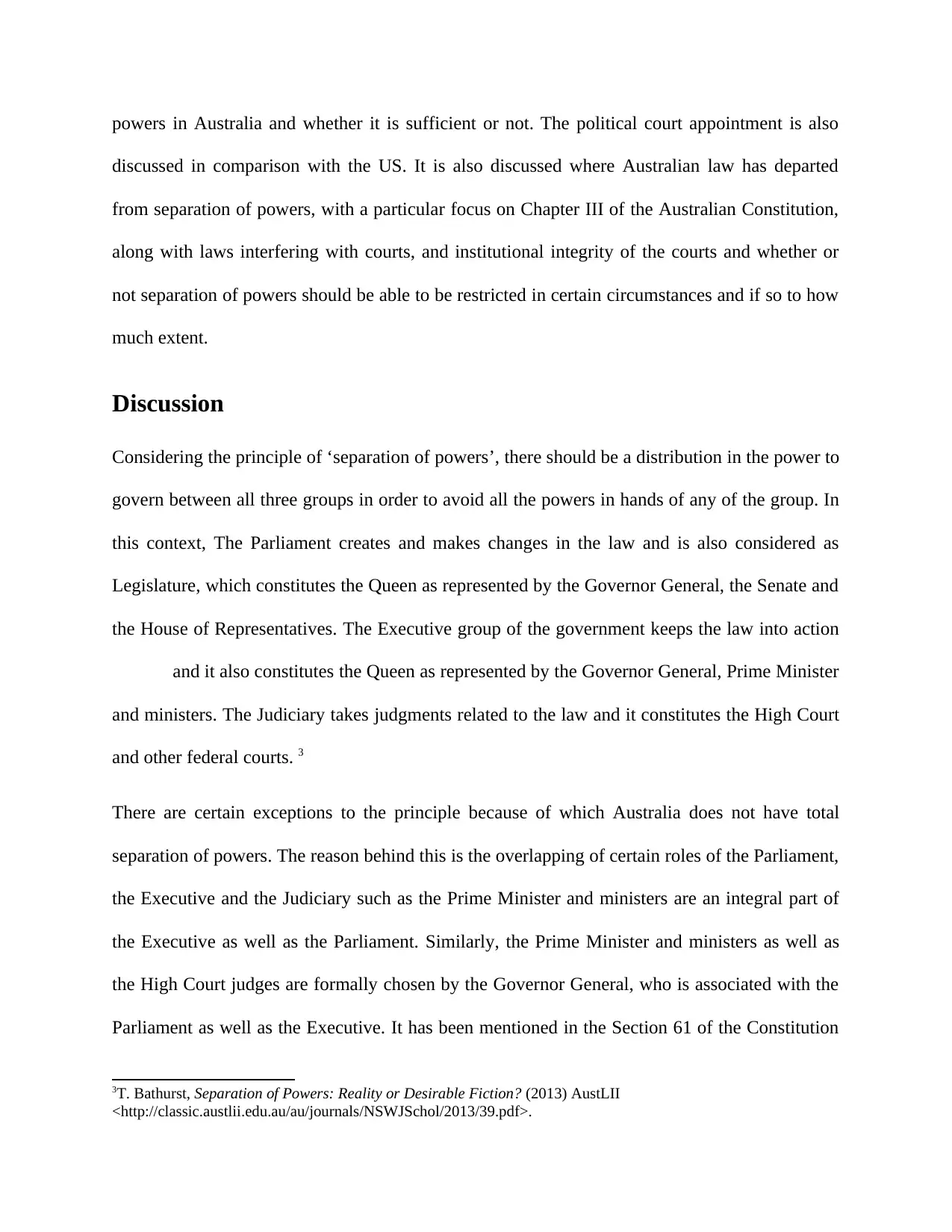
discussed in comparison with the US. It is also discussed where Australian law has departed
from separation of powers, with a particular focus on Chapter III of the Australian Constitution,
along with laws interfering with courts, and institutional integrity of the courts and whether or
not separation of powers should be able to be restricted in certain circumstances and if so to how
much extent.
Discussion
Considering the principle of ‘separation of powers’, there should be a distribution in the power to
govern between all three groups in order to avoid all the powers in hands of any of the group. In
this context, The Parliament creates and makes changes in the law and is also considered as
Legislature, which constitutes the Queen as represented by the Governor General, the Senate and
the House of Representatives. The Executive group of the government keeps the law into action
and it also constitutes the Queen as represented by the Governor General, Prime Minister
and ministers. The Judiciary takes judgments related to the law and it constitutes the High Court
and other federal courts. 3
There are certain exceptions to the principle because of which Australia does not have total
separation of powers. The reason behind this is the overlapping of certain roles of the Parliament,
the Executive and the Judiciary such as the Prime Minister and ministers are an integral part of
the Executive as well as the Parliament. Similarly, the Prime Minister and ministers as well as
the High Court judges are formally chosen by the Governor General, who is associated with the
Parliament as well as the Executive. It has been mentioned in the Section 61 of the Constitution
3T. Bathurst, Separation of Powers: Reality or Desirable Fiction? (2013) AustLII
<http://classic.austlii.edu.au/au/journals/NSWJSchol/2013/39.pdf>.
Paraphrase This Document
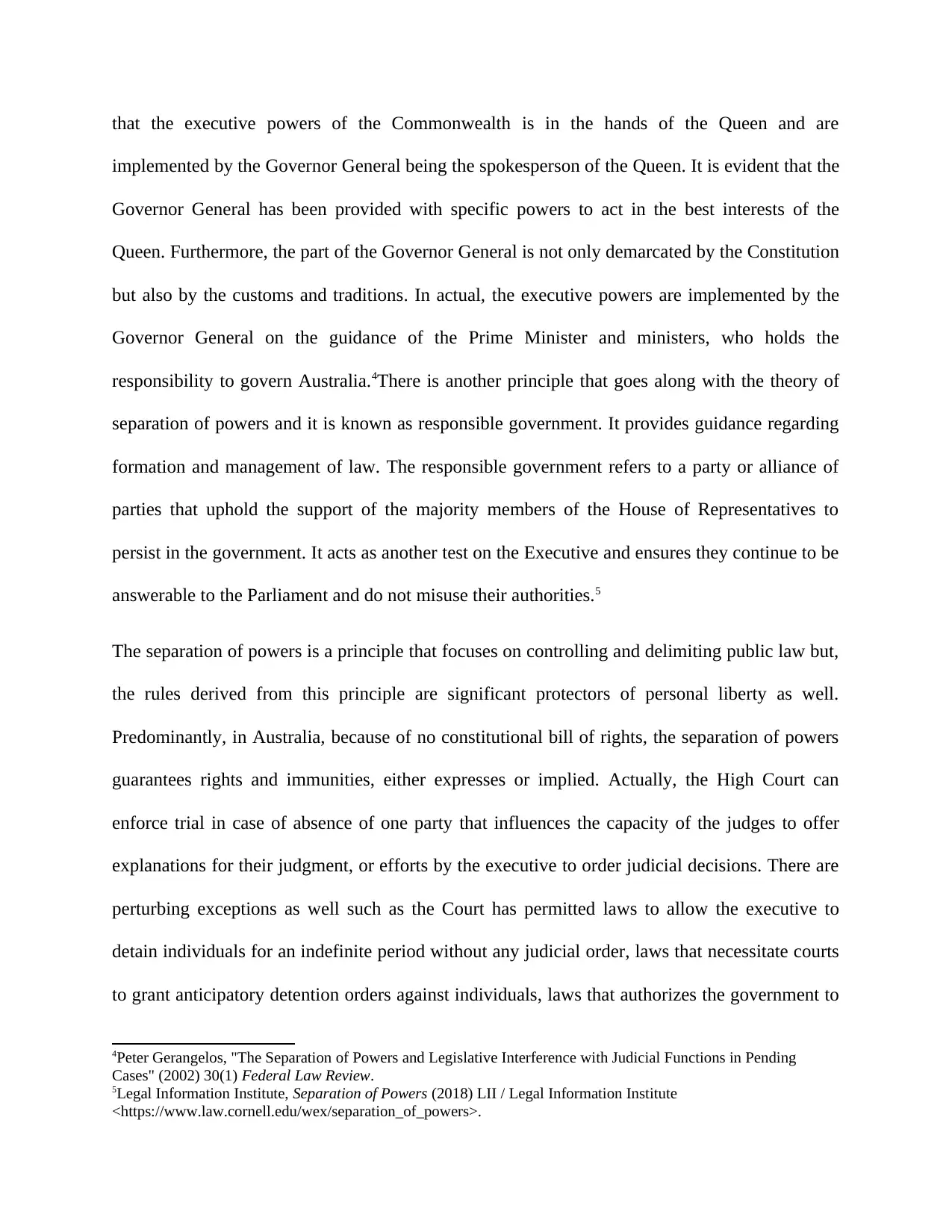
implemented by the Governor General being the spokesperson of the Queen. It is evident that the
Governor General has been provided with specific powers to act in the best interests of the
Queen. Furthermore, the part of the Governor General is not only demarcated by the Constitution
but also by the customs and traditions. In actual, the executive powers are implemented by the
Governor General on the guidance of the Prime Minister and ministers, who holds the
responsibility to govern Australia.4There is another principle that goes along with the theory of
separation of powers and it is known as responsible government. It provides guidance regarding
formation and management of law. The responsible government refers to a party or alliance of
parties that uphold the support of the majority members of the House of Representatives to
persist in the government. It acts as another test on the Executive and ensures they continue to be
answerable to the Parliament and do not misuse their authorities.5
The separation of powers is a principle that focuses on controlling and delimiting public law but,
the rules derived from this principle are significant protectors of personal liberty as well.
Predominantly, in Australia, because of no constitutional bill of rights, the separation of powers
guarantees rights and immunities, either expresses or implied. Actually, the High Court can
enforce trial in case of absence of one party that influences the capacity of the judges to offer
explanations for their judgment, or efforts by the executive to order judicial decisions. There are
perturbing exceptions as well such as the Court has permitted laws to allow the executive to
detain individuals for an indefinite period without any judicial order, laws that necessitate courts
to grant anticipatory detention orders against individuals, laws that authorizes the government to
4Peter Gerangelos, "The Separation of Powers and Legislative Interference with Judicial Functions in Pending
Cases" (2002) 30(1) Federal Law Review.
5Legal Information Institute, Separation of Powers (2018) LII / Legal Information Institute
<https://www.law.cornell.edu/wex/separation_of_powers>.
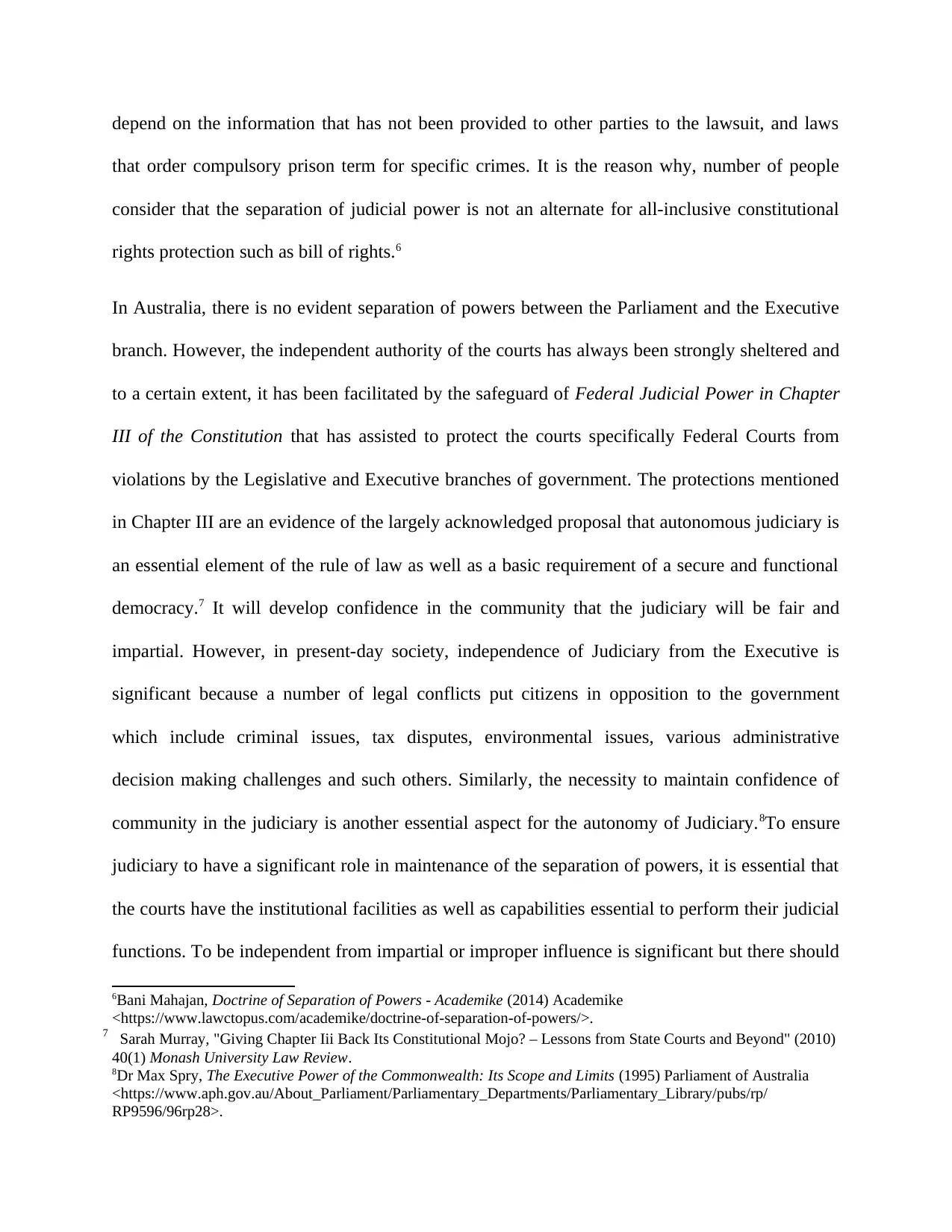
that order compulsory prison term for specific crimes. It is the reason why, number of people
consider that the separation of judicial power is not an alternate for all-inclusive constitutional
rights protection such as bill of rights.6
In Australia, there is no evident separation of powers between the Parliament and the Executive
branch. However, the independent authority of the courts has always been strongly sheltered and
to a certain extent, it has been facilitated by the safeguard of Federal Judicial Power in Chapter
III of the Constitution that has assisted to protect the courts specifically Federal Courts from
violations by the Legislative and Executive branches of government. The protections mentioned
in Chapter III are an evidence of the largely acknowledged proposal that autonomous judiciary is
an essential element of the rule of law as well as a basic requirement of a secure and functional
democracy.7 It will develop confidence in the community that the judiciary will be fair and
impartial. However, in present-day society, independence of Judiciary from the Executive is
significant because a number of legal conflicts put citizens in opposition to the government
which include criminal issues, tax disputes, environmental issues, various administrative
decision making challenges and such others. Similarly, the necessity to maintain confidence of
community in the judiciary is another essential aspect for the autonomy of Judiciary.8To ensure
judiciary to have a significant role in maintenance of the separation of powers, it is essential that
the courts have the institutional facilities as well as capabilities essential to perform their judicial
functions. To be independent from impartial or improper influence is significant but there should
6Bani Mahajan, Doctrine of Separation of Powers - Academike (2014) Academike
<https://www.lawctopus.com/academike/doctrine-of-separation-of-powers/>.
7 Sarah Murray, "Giving Chapter Iii Back Its Constitutional Mojo? – Lessons from State Courts and Beyond" (2010)
40(1) Monash University Law Review.
8Dr Max Spry, The Executive Power of the Commonwealth: Its Scope and Limits (1995) Parliament of Australia
<https://www.aph.gov.au/About_Parliament/Parliamentary_Departments/Parliamentary_Library/pubs/rp/
RP9596/96rp28>.
⊘ This is a preview!⊘
Do you want full access?
Subscribe today to unlock all pages.

Trusted by 1+ million students worldwide
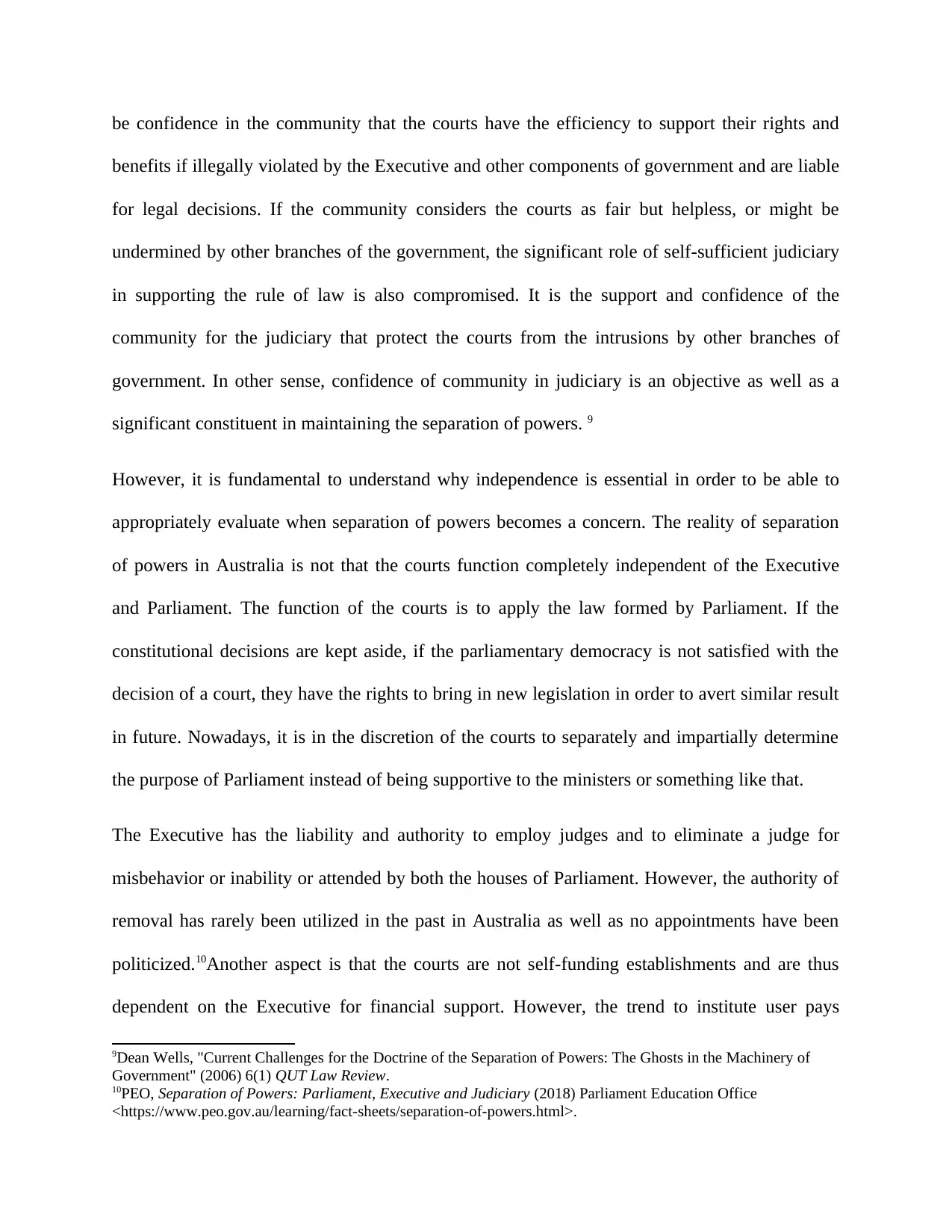
benefits if illegally violated by the Executive and other components of government and are liable
for legal decisions. If the community considers the courts as fair but helpless, or might be
undermined by other branches of the government, the significant role of self-sufficient judiciary
in supporting the rule of law is also compromised. It is the support and confidence of the
community for the judiciary that protect the courts from the intrusions by other branches of
government. In other sense, confidence of community in judiciary is an objective as well as a
significant constituent in maintaining the separation of powers. 9
However, it is fundamental to understand why independence is essential in order to be able to
appropriately evaluate when separation of powers becomes a concern. The reality of separation
of powers in Australia is not that the courts function completely independent of the Executive
and Parliament. The function of the courts is to apply the law formed by Parliament. If the
constitutional decisions are kept aside, if the parliamentary democracy is not satisfied with the
decision of a court, they have the rights to bring in new legislation in order to avert similar result
in future. Nowadays, it is in the discretion of the courts to separately and impartially determine
the purpose of Parliament instead of being supportive to the ministers or something like that.
The Executive has the liability and authority to employ judges and to eliminate a judge for
misbehavior or inability or attended by both the houses of Parliament. However, the authority of
removal has rarely been utilized in the past in Australia as well as no appointments have been
politicized.10Another aspect is that the courts are not self-funding establishments and are thus
dependent on the Executive for financial support. However, the trend to institute user pays
9Dean Wells, "Current Challenges for the Doctrine of the Separation of Powers: The Ghosts in the Machinery of
Government" (2006) 6(1) QUT Law Review.
10PEO, Separation of Powers: Parliament, Executive and Judiciary (2018) Parliament Education Office
<https://www.peo.gov.au/learning/fact-sheets/separation-of-powers.html>.
Paraphrase This Document
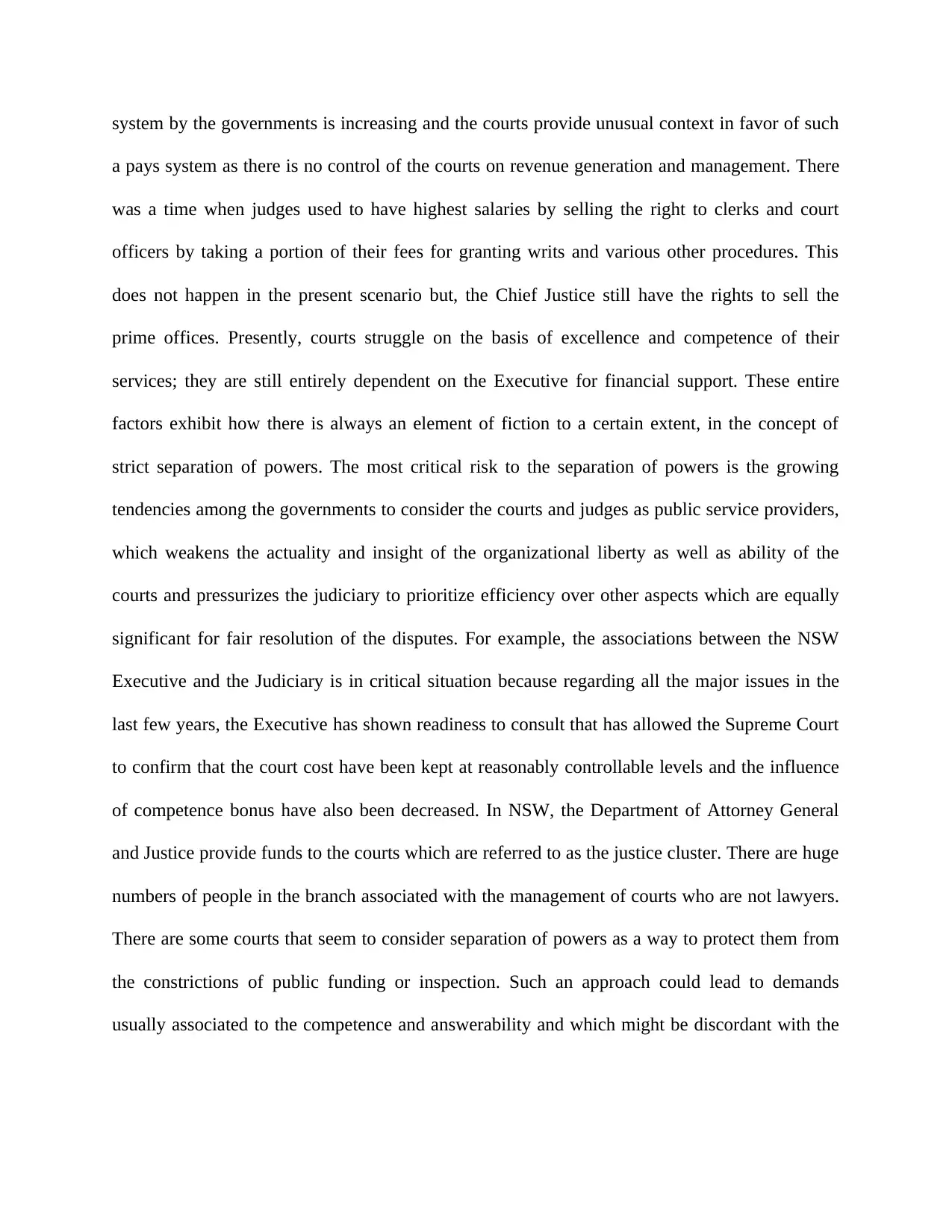
a pays system as there is no control of the courts on revenue generation and management. There
was a time when judges used to have highest salaries by selling the right to clerks and court
officers by taking a portion of their fees for granting writs and various other procedures. This
does not happen in the present scenario but, the Chief Justice still have the rights to sell the
prime offices. Presently, courts struggle on the basis of excellence and competence of their
services; they are still entirely dependent on the Executive for financial support. These entire
factors exhibit how there is always an element of fiction to a certain extent, in the concept of
strict separation of powers. The most critical risk to the separation of powers is the growing
tendencies among the governments to consider the courts and judges as public service providers,
which weakens the actuality and insight of the organizational liberty as well as ability of the
courts and pressurizes the judiciary to prioritize efficiency over other aspects which are equally
significant for fair resolution of the disputes. For example, the associations between the NSW
Executive and the Judiciary is in critical situation because regarding all the major issues in the
last few years, the Executive has shown readiness to consult that has allowed the Supreme Court
to confirm that the court cost have been kept at reasonably controllable levels and the influence
of competence bonus have also been decreased. In NSW, the Department of Attorney General
and Justice provide funds to the courts which are referred to as the justice cluster. There are huge
numbers of people in the branch associated with the management of courts who are not lawyers.
There are some courts that seem to consider separation of powers as a way to protect them from
the constrictions of public funding or inspection. Such an approach could lead to demands
usually associated to the competence and answerability and which might be discordant with the

might infrequently develop into total opposition.
It is evident now that the separation of powers is fundamental to the democracy and is also
important for protecting the citizens from power abuse by the government. It has been partially
attained by the rule of law, self-governing judiciary, and legislative or constitutional security of
public rights. The proper separation of state power supports the rule of law, which leads to
assurance of protection of liberty and freedom of individuals. The doctrine is well recognized at
central level but, it has a slight impact at the level of state government in Australia. However, the
Commonwealth Constitution emphasizes on the separation of powers between all three branches
of government, after federation, it has prioritized the States and still continues to do so. The
separation of powers in Australia is in line with the Constitution of USA that has also
commenced the separation of powers under which the legislative power is made functional by
Congress i.e. Parliament (Article I, section 1); the executive power is made functional by the
President (Article II, section 1); and the judicial power is made functional by the Supreme Court
(Article III, section 1).
There is no official but an implied separation of powers at the State level in Australia. In the past,
there had been absence of constitutional separation of powers at the level of State Government in
Australia along with Queensland. The government of Queensland had control over the
Parliament but, its answerability has been restricted because of two factors. The first factor was
the abolition of the Legislative Council in 1922 as the overall implementation of the separation
of powers would require re-introduction of upper house in Queensland, which has adopted a
unicameral system, wherein, the legislature is under strict control of the Executive as compared
to the bicameral parliamentary system. The second factor was that it had certainly not developed
⊘ This is a preview!⊘
Do you want full access?
Subscribe today to unlock all pages.

Trusted by 1+ million students worldwide
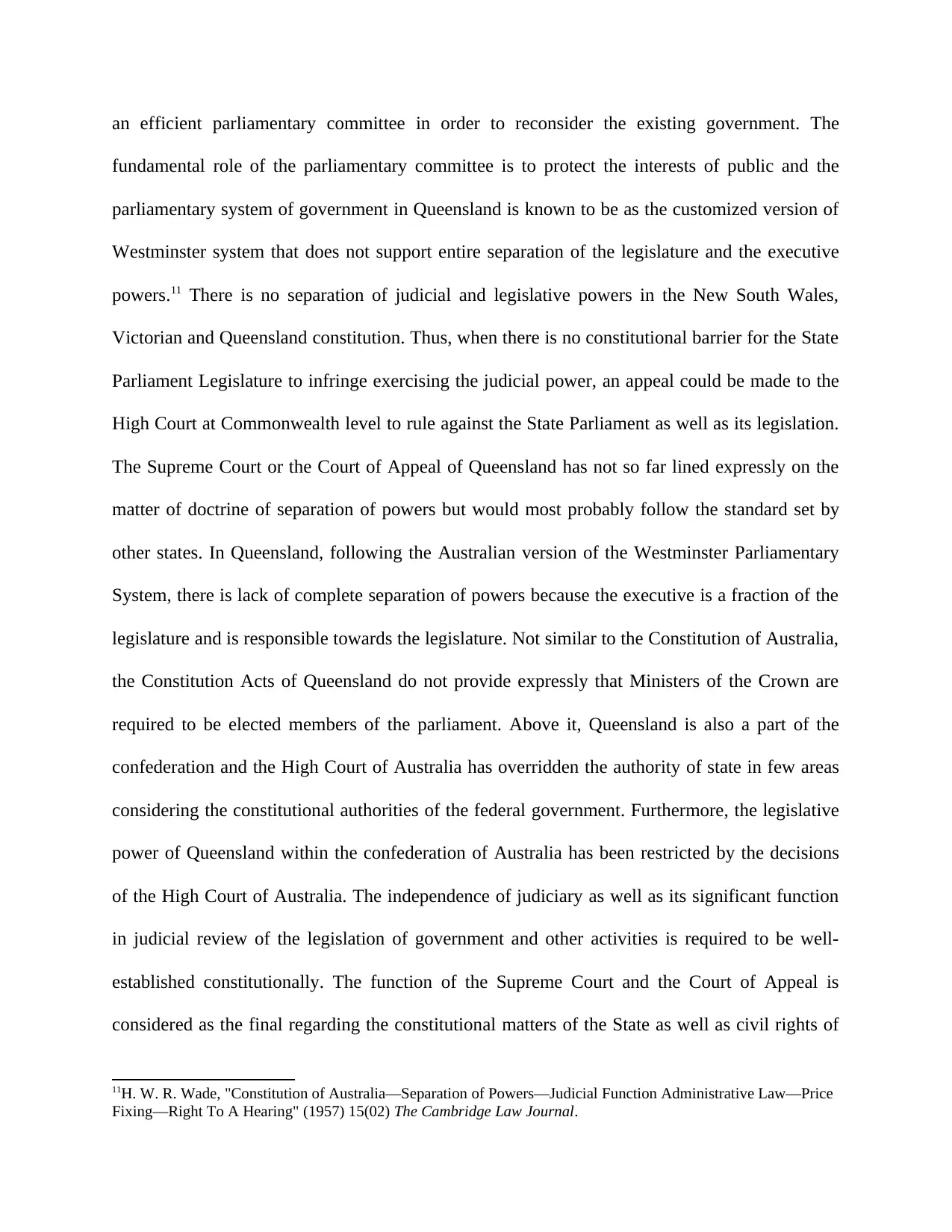
fundamental role of the parliamentary committee is to protect the interests of public and the
parliamentary system of government in Queensland is known to be as the customized version of
Westminster system that does not support entire separation of the legislature and the executive
powers.11 There is no separation of judicial and legislative powers in the New South Wales,
Victorian and Queensland constitution. Thus, when there is no constitutional barrier for the State
Parliament Legislature to infringe exercising the judicial power, an appeal could be made to the
High Court at Commonwealth level to rule against the State Parliament as well as its legislation.
The Supreme Court or the Court of Appeal of Queensland has not so far lined expressly on the
matter of doctrine of separation of powers but would most probably follow the standard set by
other states. In Queensland, following the Australian version of the Westminster Parliamentary
System, there is lack of complete separation of powers because the executive is a fraction of the
legislature and is responsible towards the legislature. Not similar to the Constitution of Australia,
the Constitution Acts of Queensland do not provide expressly that Ministers of the Crown are
required to be elected members of the parliament. Above it, Queensland is also a part of the
confederation and the High Court of Australia has overridden the authority of state in few areas
considering the constitutional authorities of the federal government. Furthermore, the legislative
power of Queensland within the confederation of Australia has been restricted by the decisions
of the High Court of Australia. The independence of judiciary as well as its significant function
in judicial review of the legislation of government and other activities is required to be well-
established constitutionally. The function of the Supreme Court and the Court of Appeal is
considered as the final regarding the constitutional matters of the State as well as civil rights of
11H. W. R. Wade, "Constitution of Australia—Separation of Powers—Judicial Function Administrative Law—Price
Fixing—Right To A Hearing" (1957) 15(02) The Cambridge Law Journal.
Paraphrase This Document
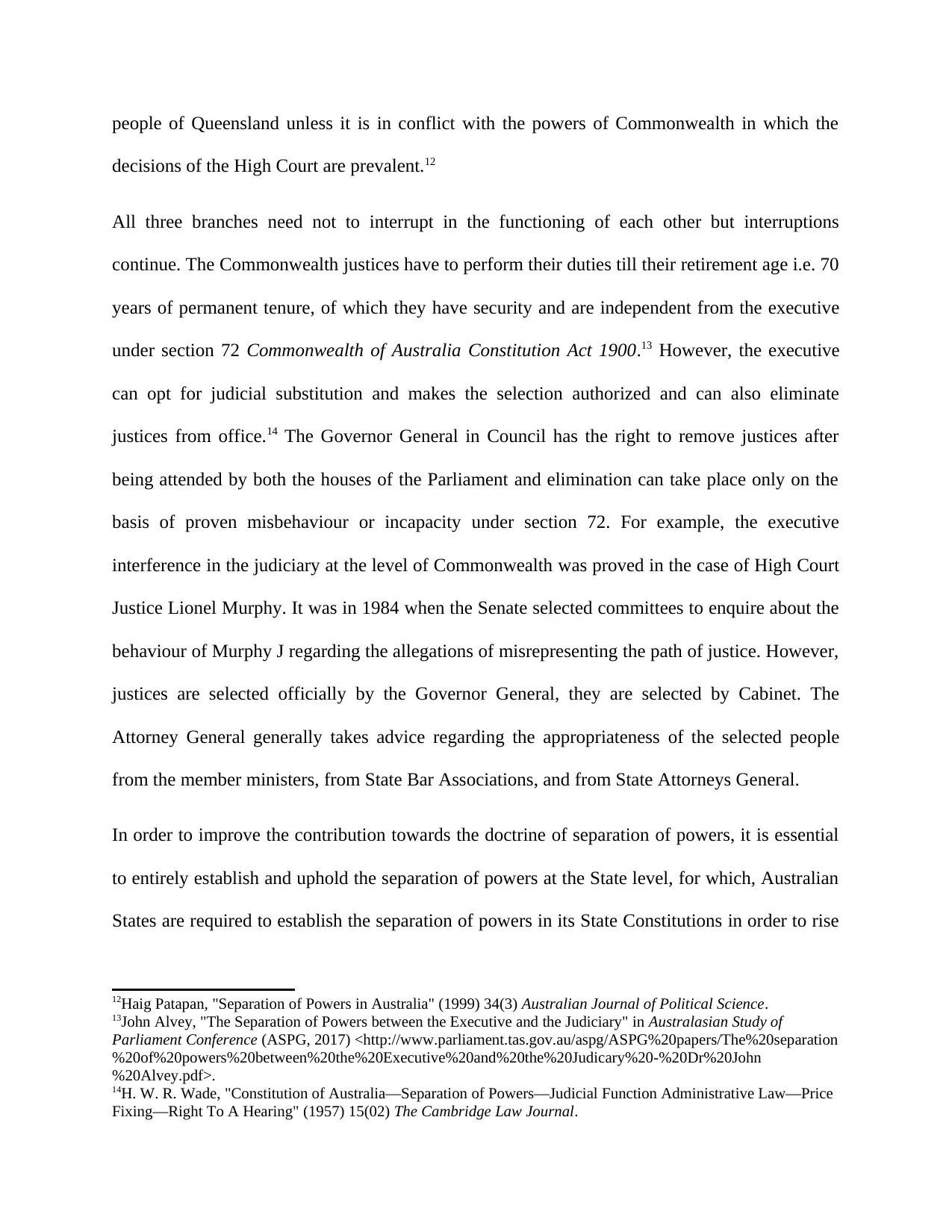
decisions of the High Court are prevalent.12
All three branches need not to interrupt in the functioning of each other but interruptions
continue. The Commonwealth justices have to perform their duties till their retirement age i.e. 70
years of permanent tenure, of which they have security and are independent from the executive
under section 72 Commonwealth of Australia Constitution Act 1900.13 However, the executive
can opt for judicial substitution and makes the selection authorized and can also eliminate
justices from office.14 The Governor General in Council has the right to remove justices after
being attended by both the houses of the Parliament and elimination can take place only on the
basis of proven misbehaviour or incapacity under section 72. For example, the executive
interference in the judiciary at the level of Commonwealth was proved in the case of High Court
Justice Lionel Murphy. It was in 1984 when the Senate selected committees to enquire about the
behaviour of Murphy J regarding the allegations of misrepresenting the path of justice. However,
justices are selected officially by the Governor General, they are selected by Cabinet. The
Attorney General generally takes advice regarding the appropriateness of the selected people
from the member ministers, from State Bar Associations, and from State Attorneys General.
In order to improve the contribution towards the doctrine of separation of powers, it is essential
to entirely establish and uphold the separation of powers at the State level, for which, Australian
States are required to establish the separation of powers in its State Constitutions in order to rise
12Haig Patapan, "Separation of Powers in Australia" (1999) 34(3) Australian Journal of Political Science.
13John Alvey, "The Separation of Powers between the Executive and the Judiciary" in Australasian Study of
Parliament Conference (ASPG, 2017) <http://www.parliament.tas.gov.au/aspg/ASPG%20papers/The%20separation
%20of%20powers%20between%20the%20Executive%20and%20the%20Judicary%20-%20Dr%20John
%20Alvey.pdf>.
14H. W. R. Wade, "Constitution of Australia—Separation of Powers—Judicial Function Administrative Law—Price
Fixing—Right To A Hearing" (1957) 15(02) The Cambridge Law Journal.

Supreme Courts in order to check the constitutional status of the State executive decisions as
well as the legislation is required to be highly entrenched into the State Constitutions. It is
essential to re-establish the parliamentary inspection of the executive decisions by Parliament to
review and approve the senior judicial appointments with the guidance of its parliamentary
committee system. There should be a formal process of nominations by the solicitors and
barristers, then a panel of judges to review senior judicial appointments by the process of
screening or short listing, and then, the Parliamentary committees should approve senior judicial
appointments.16 With a system such as Queensland with unicameral parliament, weak committee
system meeting infrequently and where the executive controls the sittings and resourcing of
parliament as well as the courts, they are to be provided with the powers to appoint judges and
sack them only after extensive parliamentary reform that has taken place.17 There are necessary
reforms of the parliamentary system and there should be more independence for parliament
itself. The re-introduction of the upper house in Queensland is also essential and a panel of
judges to monitor impending senior judicial appointments and making recommendations. There
should be an official process of nominations from attorneys and barristers and parliamentary
committee should review chosen nominees and all these phases should be completely open and
accountable.18
15National Conference of State Legislatures, Separation Of Powers--An Overview (2018) National Conference of
State Legislatures <http://www.ncsl.org/research/about-state-legislatures/separation-of-powers-an-overview.aspx>.
16Austrian Parliament, The Separation Of Powers – Why Is It Necessary? (2019) Austrian Parliament
<https://www.parlament.gv.at/ENGL/PERK/PARL/POL/ParluGewaltenteilung/index.shtml>.
17Parliament of Australia, Infosheet 20 - The Australian System Of Government (2019) Parliament of Australia
<https://www.aph.gov.au/About_Parliament/House_of_Representatives/Powers_practice_and_procedure/00_-
_Infosheets/Infosheet_20_-_The_Australian_system_of_government>.
18National Conference of State Legislatures, Separation Of Powers | Legislative, Executive, Judicial (2018) National
Conference of State Legislatures <http://www.ncsl.org/research/about-state-legislatures/separation-of-powers.aspx>.
⊘ This is a preview!⊘
Do you want full access?
Subscribe today to unlock all pages.

Trusted by 1+ million students worldwide
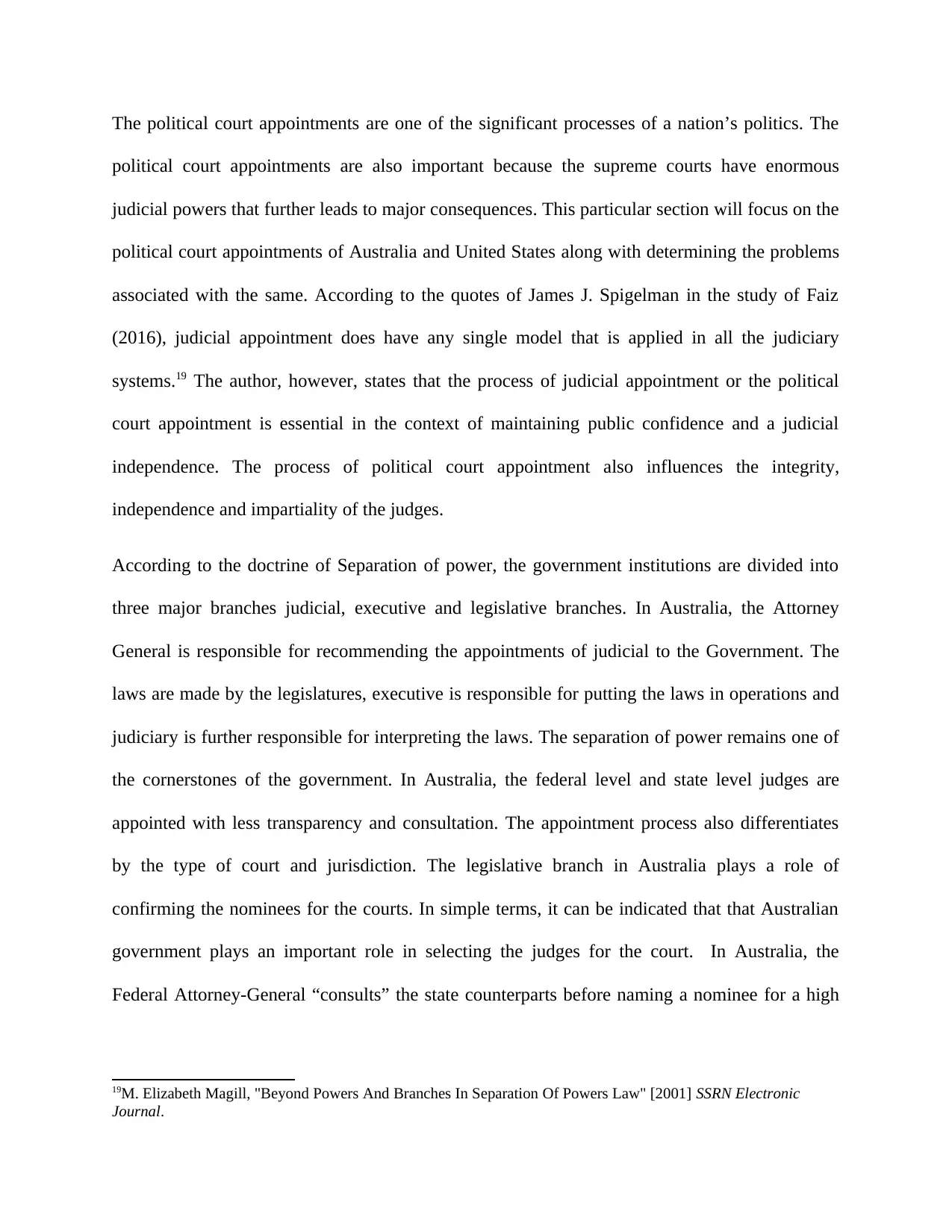
political court appointments are also important because the supreme courts have enormous
judicial powers that further leads to major consequences. This particular section will focus on the
political court appointments of Australia and United States along with determining the problems
associated with the same. According to the quotes of James J. Spigelman in the study of Faiz
(2016), judicial appointment does have any single model that is applied in all the judiciary
systems.19 The author, however, states that the process of judicial appointment or the political
court appointment is essential in the context of maintaining public confidence and a judicial
independence. The process of political court appointment also influences the integrity,
independence and impartiality of the judges.
According to the doctrine of Separation of power, the government institutions are divided into
three major branches judicial, executive and legislative branches. In Australia, the Attorney
General is responsible for recommending the appointments of judicial to the Government. The
laws are made by the legislatures, executive is responsible for putting the laws in operations and
judiciary is further responsible for interpreting the laws. The separation of power remains one of
the cornerstones of the government. In Australia, the federal level and state level judges are
appointed with less transparency and consultation. The appointment process also differentiates
by the type of court and jurisdiction. The legislative branch in Australia plays a role of
confirming the nominees for the courts. In simple terms, it can be indicated that that Australian
government plays an important role in selecting the judges for the court. In Australia, the
Federal Attorney-General “consults” the state counterparts before naming a nominee for a high
19M. Elizabeth Magill, "Beyond Powers And Branches In Separation Of Powers Law" [2001] SSRN Electronic
Journal.
Paraphrase This Document
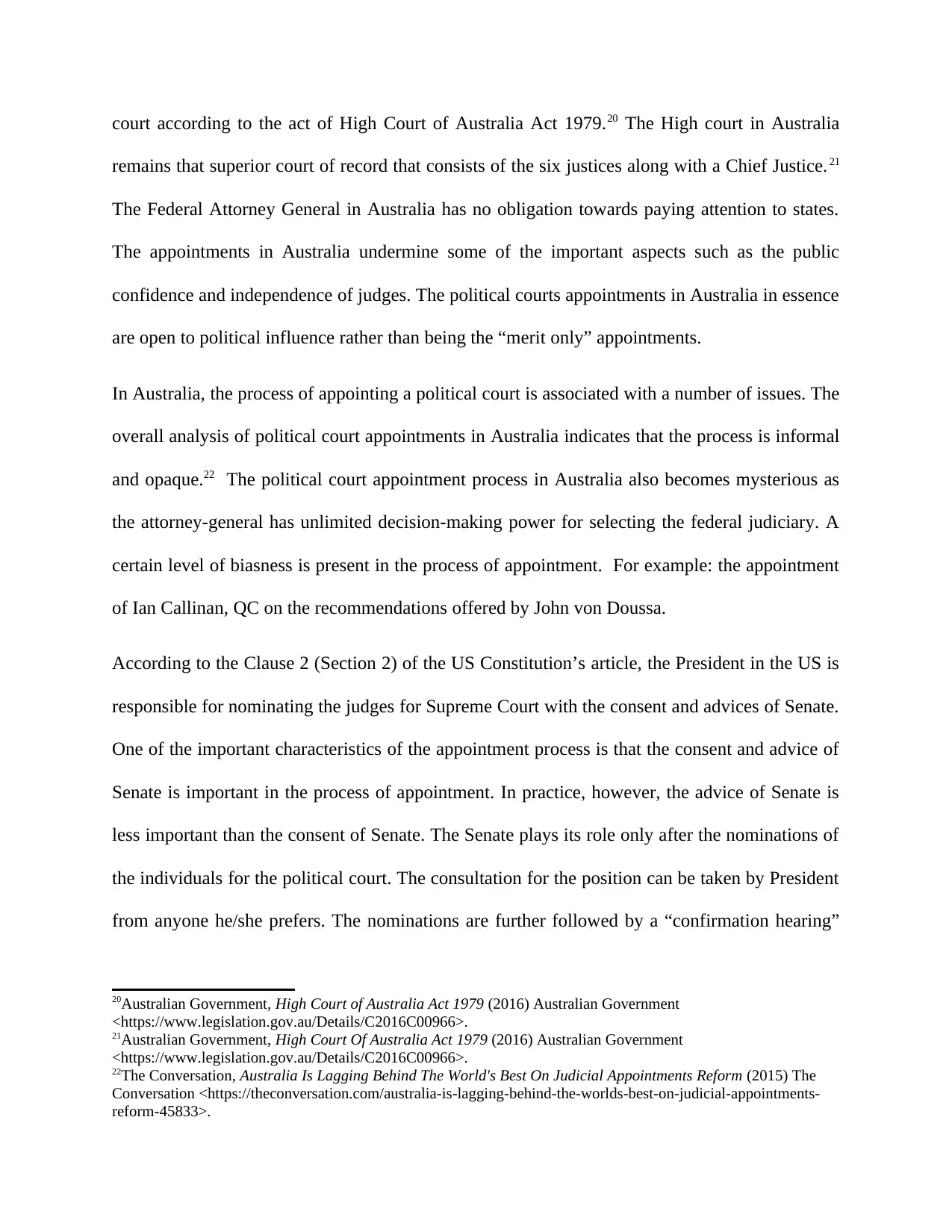
remains that superior court of record that consists of the six justices along with a Chief Justice.21
The Federal Attorney General in Australia has no obligation towards paying attention to states.
The appointments in Australia undermine some of the important aspects such as the public
confidence and independence of judges. The political courts appointments in Australia in essence
are open to political influence rather than being the “merit only” appointments.
In Australia, the process of appointing a political court is associated with a number of issues. The
overall analysis of political court appointments in Australia indicates that the process is informal
and opaque.22 The political court appointment process in Australia also becomes mysterious as
the attorney-general has unlimited decision-making power for selecting the federal judiciary. A
certain level of biasness is present in the process of appointment. For example: the appointment
of Ian Callinan, QC on the recommendations offered by John von Doussa.
According to the Clause 2 (Section 2) of the US Constitution’s article, the President in the US is
responsible for nominating the judges for Supreme Court with the consent and advices of Senate.
One of the important characteristics of the appointment process is that the consent and advice of
Senate is important in the process of appointment. In practice, however, the advice of Senate is
less important than the consent of Senate. The Senate plays its role only after the nominations of
the individuals for the political court. The consultation for the position can be taken by President
from anyone he/she prefers. The nominations are further followed by a “confirmation hearing”
20Australian Government, High Court of Australia Act 1979 (2016) Australian Government
<https://www.legislation.gov.au/Details/C2016C00966>.
21Australian Government, High Court Of Australia Act 1979 (2016) Australian Government
<https://www.legislation.gov.au/Details/C2016C00966>.
22The Conversation, Australia Is Lagging Behind The World's Best On Judicial Appointments Reform (2015) The
Conversation <https://theconversation.com/australia-is-lagging-behind-the-worlds-best-on-judicial-appointments-
reform-45833>.
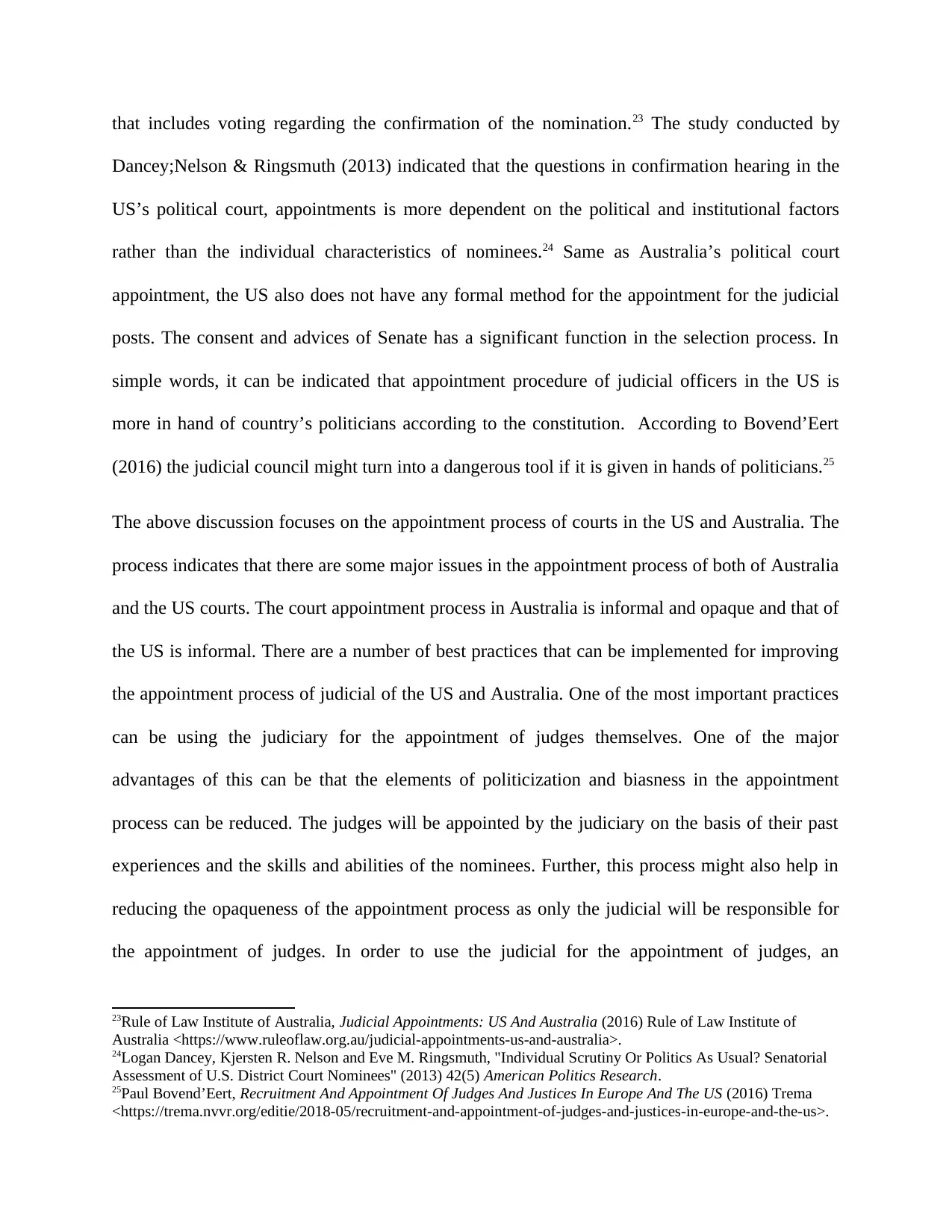
Dancey;Nelson & Ringsmuth (2013) indicated that the questions in confirmation hearing in the
US’s political court, appointments is more dependent on the political and institutional factors
rather than the individual characteristics of nominees.24 Same as Australia’s political court
appointment, the US also does not have any formal method for the appointment for the judicial
posts. The consent and advices of Senate has a significant function in the selection process. In
simple words, it can be indicated that appointment procedure of judicial officers in the US is
more in hand of country’s politicians according to the constitution. According to Bovend’Eert
(2016) the judicial council might turn into a dangerous tool if it is given in hands of politicians.25
The above discussion focuses on the appointment process of courts in the US and Australia. The
process indicates that there are some major issues in the appointment process of both of Australia
and the US courts. The court appointment process in Australia is informal and opaque and that of
the US is informal. There are a number of best practices that can be implemented for improving
the appointment process of judicial of the US and Australia. One of the most important practices
can be using the judiciary for the appointment of judges themselves. One of the major
advantages of this can be that the elements of politicization and biasness in the appointment
process can be reduced. The judges will be appointed by the judiciary on the basis of their past
experiences and the skills and abilities of the nominees. Further, this process might also help in
reducing the opaqueness of the appointment process as only the judicial will be responsible for
the appointment of judges. In order to use the judicial for the appointment of judges, an
23Rule of Law Institute of Australia, Judicial Appointments: US And Australia (2016) Rule of Law Institute of
Australia <https://www.ruleoflaw.org.au/judicial-appointments-us-and-australia>.
24Logan Dancey, Kjersten R. Nelson and Eve M. Ringsmuth, "Individual Scrutiny Or Politics As Usual? Senatorial
Assessment of U.S. District Court Nominees" (2013) 42(5) American Politics Research.
25Paul Bovend’Eert, Recruitment And Appointment Of Judges And Justices In Europe And The US (2016) Trema
<https://trema.nvvr.org/editie/2018-05/recruitment-and-appointment-of-judges-and-justices-in-europe-and-the-us>.
⊘ This is a preview!⊘
Do you want full access?
Subscribe today to unlock all pages.

Trusted by 1+ million students worldwide

decisions about the suitable candidate for the judicial position. In addition, in order to improve
the appointment process in both the nations, focus should be on being transparent in each stage
of appointment. Transparency can be ensured by information sharing with help of online and
offline mediums.
Such an “accountable” appointment system should have three key attributes: 1. A nominating
commission with diverse membership and appointing authorities, which will vet judicial
candidates and create a shortlist of nominees; 2. Appointment by the governor from the
commission’s shortlist; and 3. A transparent process, including data collection and ethics rules
for commissioners.
Access to justice can be improved in various ways, for example, by providing general
information about the length and costs of proceedings, by providing legal aid, the provision of
judgments online, etc. Making the justice system more transparent is therefore just one of the
ways to make justice more accessible and thus more effective.
Section 61 of the Constitution is the precursor of the executive power of the Commonwealth.
Discussing the characteristic of section 61 in Davis v The Commonwealth (1988), Mason CJ,
Deane and Gaudron JJ stated that the extent of the executive power of the Commonwealth has
been talked about but has never been defined.26 Section 61 states that the executive power of the
Commonwealth is with the Queen and made functional by the Governor General being the
delegate of Queen and also extends to the implementation and preservation of this Constitution
as well as of the Commonwealth laws.27 The interpretation of section 61 is formed by two
26David Jenkins, "The Lockean Constitution: Separation Of Powers And The Limits Of Prerogative" (2011)
56(3) McGill Law Journal.
27ALRC, The Separation of Powers (2019) Australian Law Reform Commission
<https://www.alrc.gov.au/publications/separation-powers>.
Paraphrase This Document

government with sufficient powers as well as adequate executive judgment in order to conduct
state affairs as they occur. On the other hand, the executive powers must not be so unrestricted in
order to agree for the random action. The High Court has exhibited an enduring concern that
alternative to the executive power might become a tool for the Commonwealth encroaching the
rights as well as functions of the States. It was initially considered by the Court that section 61
authorized the implementation and preservation of the Constitution as well as of legislation
sanctioned by Parliament. It has been stated by the Knox CJ and Gavan Duffy J in
Commonwealth v Colonial Combing, Spinning & Weaving Co, that section 61 set the limits of
the authority by declaring that it is up to the preservation of the Constitution and laws of the
Commonwealth. The capacity of the Executive to get into contracts without the sanction of
Parliament had been taken into consideration by the High Court in this case.28 The Court decided
that the Executive could not involve into contracts without prior sanction of the Parliament.
Excluding, any rights discussed by Parliament of the Commonwealth or by the regulations, the
Executive of the Commonwealth did not have any authority to create or approve any of the
agreement. Justice Isaacs stated that unless sanctioned by Commonwealth legislation, the
Executive Government would have no authority to make any of the contracts.29 In Constitution
Law of Australia, the attitude of the Court towards the ability of the Executive to involve in
contracts isn’t in agreement with the New South Wales v Bardolph (1934), it was decided by the
High Court that the Executive could reasonably get into a binding contract without parliamentary
authorization. It has also been decided by the Justice Dixon that it is a job of the Executive not of
28John Alvey, "The Separation of Powers in Australia: Implications For The State Of Queensland" in 53rd
Australasian Political Studies Association Conference (APSA, 2005) <http://www.cpahq.org/cpahq/cpadocs/The
%20Separation%20of%20Powers%20in%20Australia%20Issues%20for%20the%20States.pdf>.
29Australian Government, High Court of Australia Act 1979 (2016) Legislation.gov.au
<https://www.legislation.gov.au/Details/C2016C00966>.
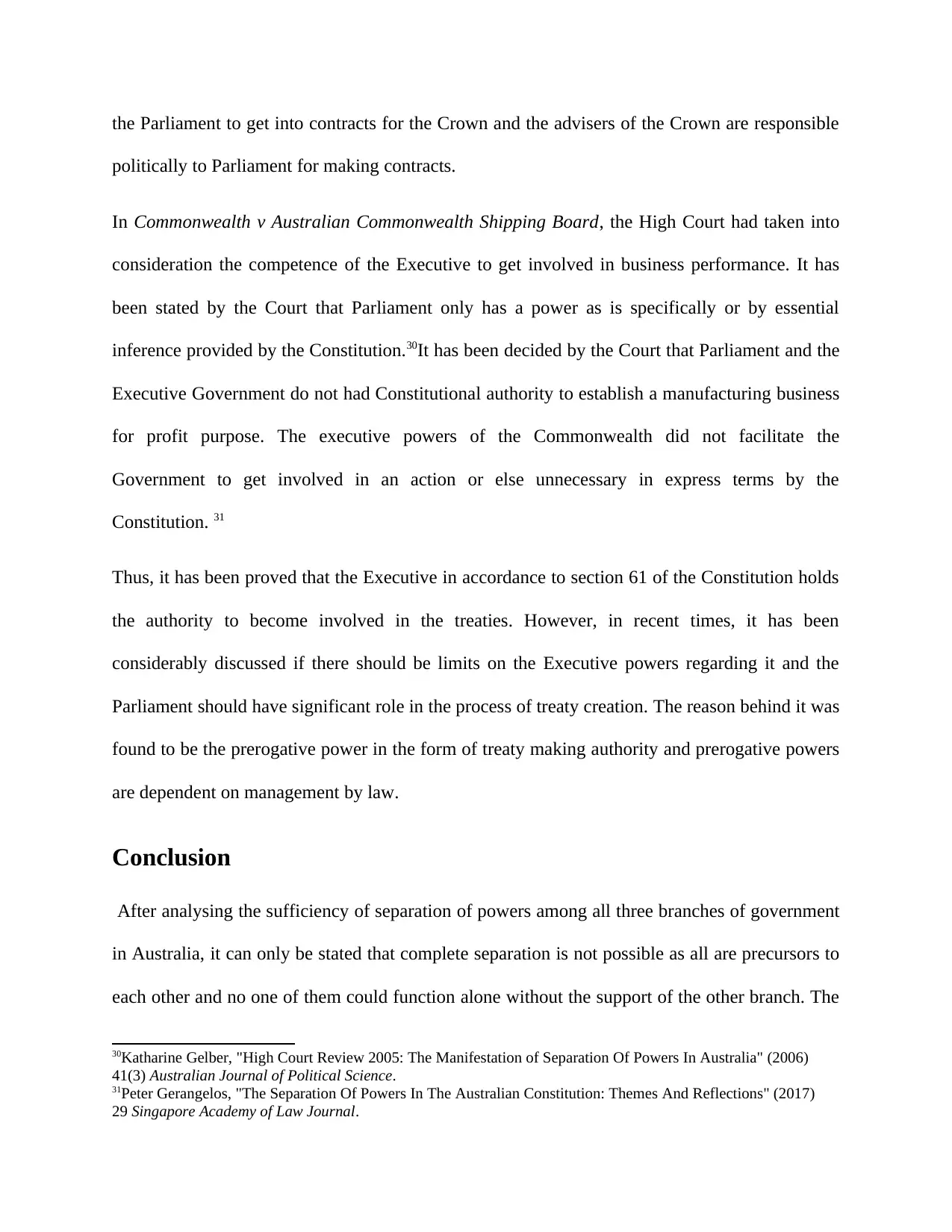
politically to Parliament for making contracts.
In Commonwealth v Australian Commonwealth Shipping Board, the High Court had taken into
consideration the competence of the Executive to get involved in business performance. It has
been stated by the Court that Parliament only has a power as is specifically or by essential
inference provided by the Constitution.30It has been decided by the Court that Parliament and the
Executive Government do not had Constitutional authority to establish a manufacturing business
for profit purpose. The executive powers of the Commonwealth did not facilitate the
Government to get involved in an action or else unnecessary in express terms by the
Constitution. 31
Thus, it has been proved that the Executive in accordance to section 61 of the Constitution holds
the authority to become involved in the treaties. However, in recent times, it has been
considerably discussed if there should be limits on the Executive powers regarding it and the
Parliament should have significant role in the process of treaty creation. The reason behind it was
found to be the prerogative power in the form of treaty making authority and prerogative powers
are dependent on management by law.
Conclusion
After analysing the sufficiency of separation of powers among all three branches of government
in Australia, it can only be stated that complete separation is not possible as all are precursors to
each other and no one of them could function alone without the support of the other branch. The
30Katharine Gelber, "High Court Review 2005: The Manifestation of Separation Of Powers In Australia" (2006)
41(3) Australian Journal of Political Science.
31Peter Gerangelos, "The Separation Of Powers In The Australian Constitution: Themes And Reflections" (2017)
29 Singapore Academy of Law Journal.
⊘ This is a preview!⊘
Do you want full access?
Subscribe today to unlock all pages.

Trusted by 1+ million students worldwide
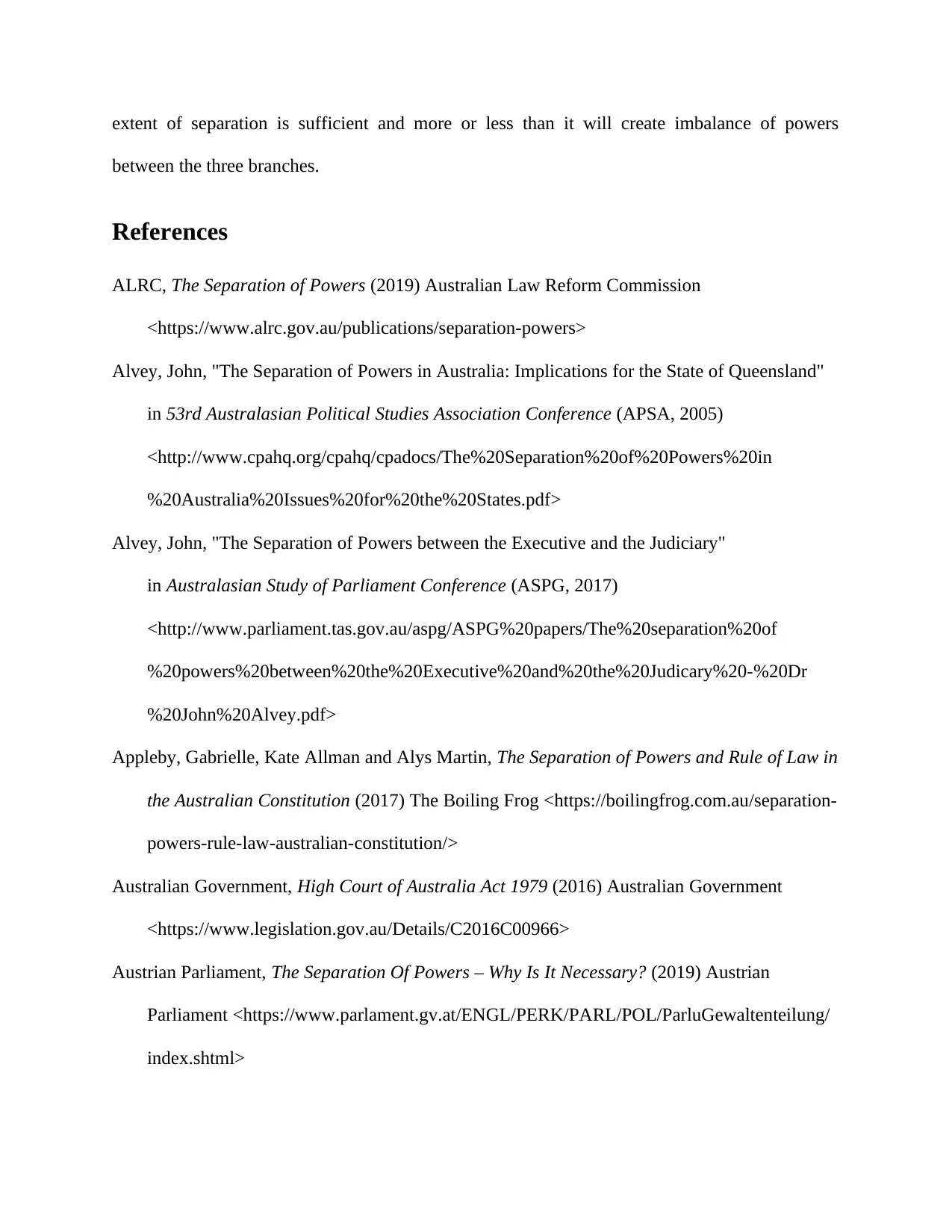
between the three branches.
References
ALRC, The Separation of Powers (2019) Australian Law Reform Commission
<https://www.alrc.gov.au/publications/separation-powers>
Alvey, John, "The Separation of Powers in Australia: Implications for the State of Queensland"
in 53rd Australasian Political Studies Association Conference (APSA, 2005)
<http://www.cpahq.org/cpahq/cpadocs/The%20Separation%20of%20Powers%20in
%20Australia%20Issues%20for%20the%20States.pdf>
Alvey, John, "The Separation of Powers between the Executive and the Judiciary"
in Australasian Study of Parliament Conference (ASPG, 2017)
<http://www.parliament.tas.gov.au/aspg/ASPG%20papers/The%20separation%20of
%20powers%20between%20the%20Executive%20and%20the%20Judicary%20-%20Dr
%20John%20Alvey.pdf>
Appleby, Gabrielle, Kate Allman and Alys Martin, The Separation of Powers and Rule of Law in
the Australian Constitution (2017) The Boiling Frog <https://boilingfrog.com.au/separation-
powers-rule-law-australian-constitution/>
Australian Government, High Court of Australia Act 1979 (2016) Australian Government
<https://www.legislation.gov.au/Details/C2016C00966>
Austrian Parliament, The Separation Of Powers – Why Is It Necessary? (2019) Austrian
Parliament <https://www.parlament.gv.at/ENGL/PERK/PARL/POL/ParluGewaltenteilung/
index.shtml>
Paraphrase This Document
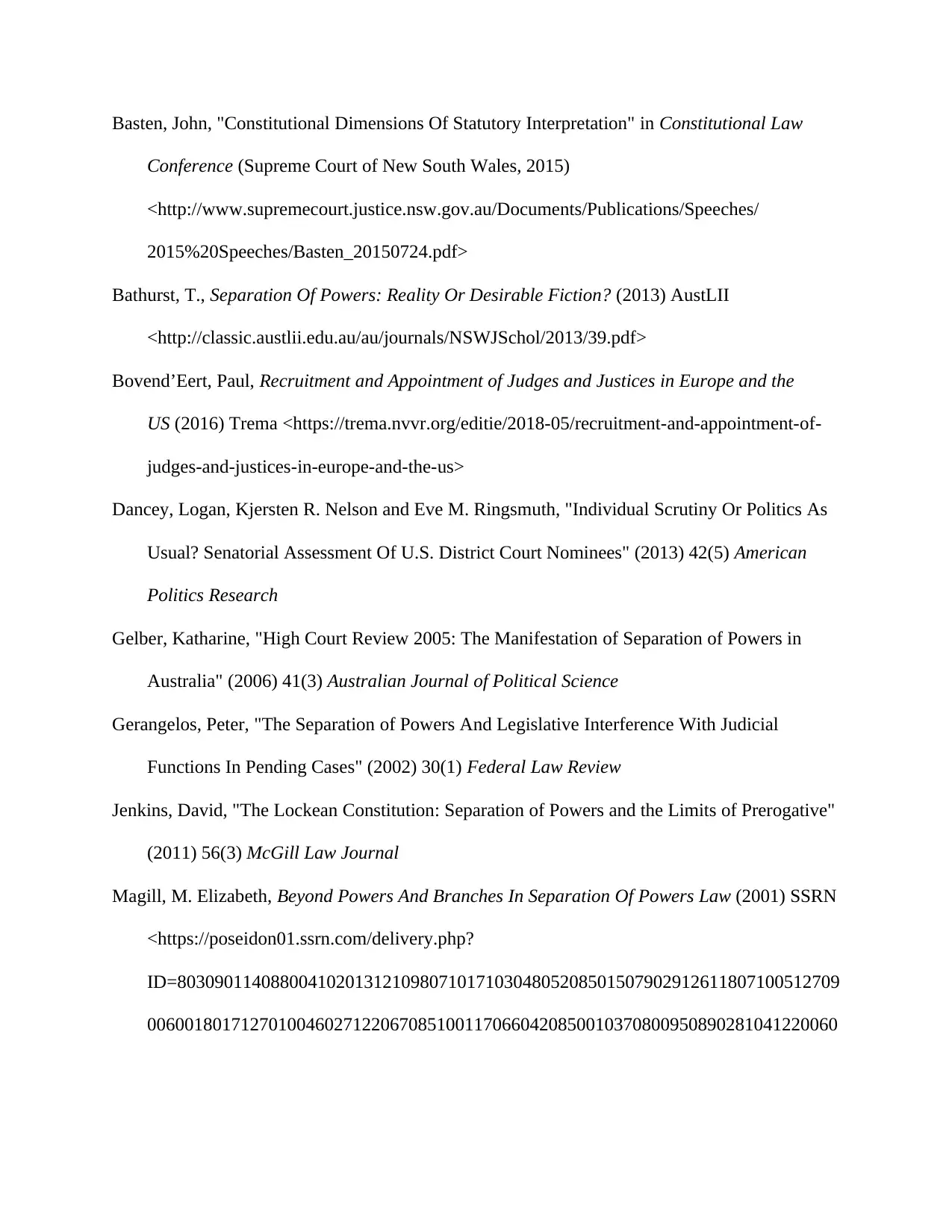
Conference (Supreme Court of New South Wales, 2015)
<http://www.supremecourt.justice.nsw.gov.au/Documents/Publications/Speeches/
2015%20Speeches/Basten_20150724.pdf>
Bathurst, T., Separation Of Powers: Reality Or Desirable Fiction? (2013) AustLII
<http://classic.austlii.edu.au/au/journals/NSWJSchol/2013/39.pdf>
Bovend’Eert, Paul, Recruitment and Appointment of Judges and Justices in Europe and the
US (2016) Trema <https://trema.nvvr.org/editie/2018-05/recruitment-and-appointment-of-
judges-and-justices-in-europe-and-the-us>
Dancey, Logan, Kjersten R. Nelson and Eve M. Ringsmuth, "Individual Scrutiny Or Politics As
Usual? Senatorial Assessment Of U.S. District Court Nominees" (2013) 42(5) American
Politics Research
Gelber, Katharine, "High Court Review 2005: The Manifestation of Separation of Powers in
Australia" (2006) 41(3) Australian Journal of Political Science
Gerangelos, Peter, "The Separation of Powers And Legislative Interference With Judicial
Functions In Pending Cases" (2002) 30(1) Federal Law Review
Jenkins, David, "The Lockean Constitution: Separation of Powers and the Limits of Prerogative"
(2011) 56(3) McGill Law Journal
Magill, M. Elizabeth, Beyond Powers And Branches In Separation Of Powers Law (2001) SSRN
<https://poseidon01.ssrn.com/delivery.php?
ID=80309011408800410201312109807101710304805208501507902912611807100512709
00600180171270100460271220670851001170660420850010370800950890281041220060

011087066066106127017103&EXT=pdf>
Mahajan, Bani, Doctrine of Separation of Powers (2014) Academike
<https://www.lawctopus.com/academike/doctrine-of-separation-of-powers/>
Murray, Sarah, "Giving Chapter Iii Back Its Constitutional Mojo? – Lessons from State Courts
and Beyond" (2010) 40(1) Monash University Law Review
National Conference of State Legislatures, Separation of Powers--An Overview (2018) National
Conference of State Legislatures
<http://www.ncsl.org/research/about-state-legislatures/separation-of-powers-an-
overview.aspx>
National Conference of State Legislatures, Separation of Powers | Legislative, Executive,
Judicial (2018) National Conference of State Legislatures
<http://www.ncsl.org/research/about-state-legislatures/separation-of-powers.aspx>
Parliament of Australia, Infosheet 20 - The Australian System Of Government (2019) Parliament
of Australia <https://www.aph.gov.au/About_Parliament/House_of_Representatives/
Powers_practice_and_procedure/00_-_Infosheets/Infosheet_20_-
_The_Australian_system_of_government>
Patapan, Haig, "Separation of Powers in Australia" (1999) 34(3) Australian Journal of Political
Science
PEO, Separation Of Powers: Parliament, Executive And Judiciary (2018) Parliament Education
Office <https://www.peo.gov.au/learning/fact-sheets/separation-of-powers.html>
LII, Separation of Powers (2018) Legal Information Institute
<https://www.law.cornell.edu/wex/separation_of_powers>
⊘ This is a preview!⊘
Do you want full access?
Subscribe today to unlock all pages.

Trusted by 1+ million students worldwide

Institute of Australia <https://www.ruleoflaw.org.au/judicial-appointments-us-and-
australia>
Spry, Dr Max, The Executive Power of the Commonwealth: Its Scope and Limits (1995)
Parliament Of Australia
<https://www.aph.gov.au/About_Parliament/Parliamentary_Departments/
Parliamentary_Library/pubs/rp/RP9596/96rp28>
The Conversation, Australia is lagging Behind the World's Best on Judicial Appointments
Reform (2015) The Conversation <https://theconversation.com/australia-is-lagging-behind-
the-worlds-best-on-judicial-appointments-reform-45833>
Wade, H. W. R., "Constitution of Australia—Separation of Powers—Judicial Function
Administrative Law—Price Fixing—Right To A Hearing" (1957) 15(02) The Cambridge
Law Journal
Wells, Dean, "Current Challenges For The Doctrine Of The Separation Of Powers: The Ghosts
In The Machinery Of Government" (2006) 6(1) QUT Law Review
Related Documents
Your All-in-One AI-Powered Toolkit for Academic Success.
+13062052269
info@desklib.com
Available 24*7 on WhatsApp / Email
![[object Object]](/_next/static/media/star-bottom.7253800d.svg)
© 2024 | Zucol Services PVT LTD | All rights reserved.





